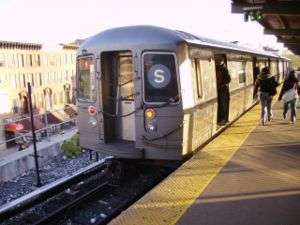MS Multi-section car (New York City Subway car)
The MS Multi-section, a series of New York City Subway cars, was built in prototype form in 1934 with production models built in 1936. They were called "Multis" for short.
Background
The MS was an articulated car made up of five sections. Their average length was 170 ft (52 m), making them the longest articulated units ever used in the history of the BMT. The first two pilot cars, numbered 7003 and 7029, were delivered in 1934 by the Budd Company and Pullman Company. The Pullman version was known as the Green Hornet, while Budd's was called the Zephyr, both names being unofficial. The Green Hornet (and the 25 production cars) had two double-leaf doors on each section (10 doors per unit), while the Zephyr had four single-leaf doors on each section (20 doors per unit). These cars were in production at the same time as the Union Pacific M-10000 and the Budd Pioneer Zephyr for the CB&Q. Testing of these cars proved successful and the BMT ordered a further 25 cars, 15 from Pullman and 10 from St. Louis Car Co.
History
The two units were initially tested on the Fulton St. el for comparison, and when the tests were concluded they were relegated to Franklin Ave. Shuttle service, almost never appearing in through service to Brighton Beach or Coney Island except occasionally for put-ins or layups.
The Green Hornet had undergone some slight modifications, and the BMT management hoped to eventually run it in consists with the Pullman-Standard built Multi units. However, with the onset of World War II, the Green Hornet was scrapped in 1942 for its valuable aluminum body. The unit had been plagued by master controller problems and was only in service for three years before it was withdrawn after maintenance revealed two cracked trucks. The Zephyr had a much better service record and remained in service on the Franklin Avenue Shuttle until it was retired in 1954. The unit was scrapped in 1959.
The 25 production cars were introduced in 1936, but were quickly withdrawn from service for truck modifications. The St. Louis built units over the years were particularly troublesome in that regard.
They were returned to service one year later and began serving on the Canarsie Line. In December, 1956, they were transferred to Myrtle-Chambers service for purposes of cutting their mileage, as was commonly done at the time with all oddball types of equipment. One train in addition ran in the Broadway Short Line service. In February, 1958, a few units underwent a one week stint in Franklin Ave. service (shuttle and on the last day, a Sunday, local to Brighton Beach). They were retired from service on September 5, 1961 and scrapped later that year.
The MS was notable for its rapid acceleration rate (4 mph/s or 6.4 km/(h·s) for the Green Hornet and the 25 production cars, and 5 mph/s or 8.0 km/(h·s) for the Zephyr) and its "balancing speed" — the maximum speed attainable on level track, running empty — was relatively high (53 mph or 85 km/h for the Green Hornet, 55 mph or 89 km/h for the Zephyr, and 58 mph or 93 km/h for the 25 production units).
Another interesting fact was that the Zephyr was built without couplers, so it could only operate as a single unit.
MS Multi-section Specifications
- Car Builder: Pullman - 7003, 7014-7028 / St Louis Car 7004-7013 /Budd - 7029
- Car Body:
- Unit Numbers: 7003, 7014-7028, 7004-7013, 7029
- Fleet: 27 units
- Car Length: 168 ft 6 in (51.36 m) (Zephyr)/170 ft (51.82 m) (Green Hornet)/179 ft 4 in (54.66 m) (production cars)
- Car Width: 10 ft (3.05 m) over thresholds (Green Hornet and Zephyr)/ 10 ft 10 in (3.30 m) over thresholds (production cars)
- Car Height: 12 ft (3.66 m) (Green Hornet and production cars)/11 ft 7.5 in (3.54 m) (Zephyr)
- Track Gauge: 4 ft 8 1⁄2 in (1,435 mm).
- Propulsion System: Westinghouse XD29 P.C.C. Multi-Notch 47 pts (Green Hornet, and St. Louis Car production cars), General Electric 17KG39A1 (Pullman Standard production cars), 17KG21A (Zephyr "C" car), 17KM1C (Zephyr "A, A1" cars)
- Motors (on every axle):Westinghouse M1431A, 1433, General Electric 1196A1, 1186
- Power (per motor) : 70 hp (52 kW)
- Total Seating: 170, 184, 198 (Zephyr, Green Hornet, production Cars)
- Total Standing: 496, 490, 514 (Zephyr, Green Hornet, production Cars)
- Total Weight: 170,610 lb (77,387 kg) (Green Hornet), 159,250 lb (72,235 kg) (Zephyr), 180,830 lb (82,023 kg) (production cars)
Further reading
- Sansone, Gene. Evolution of New York City subways: An illustrated history of New York City's transit cars, 1867-1997. New York Transit Museum Press, New York, 1997 ISBN 978-0-9637492-8-4


